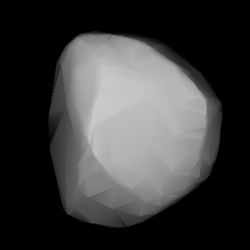Nuwa (minor planet designation: 150 Nuwa) is a large main-belt asteroid with an orbital period of 5.15 years. It was discovered by Canadian-American astronomer James Craig Watson on October 18, 1875,[6] and named after Nüwa, the Chinese creator goddess. This object is a candidate member of the Hecuba group of asteroids that orbit near the 2:1 mean-motion resonance with Jupiter.[7] Based upon the spectrum it is classified as a C-type asteroid,[8] which indicates that it is probably composed of primitive carbonaceous chondritic material and the surface is exceedingly dark.
 3D convex shape model of 150 Nuwa | |
| Discovery | |
|---|---|
| Discovered by | J. C. Watson |
| Discovery date | 18 October 1875 |
| Designations | |
| (150) Nuwa | |
| Pronunciation | /ˈnjuːwɑː/[citation needed] |
Named after | Nüwa |
| A875 UA; 1908 AL; 2002 JR70 | |
| Main belt | |
| Orbital characteristics[1] | |
| Epoch 31 July 2016 (JD 2457600.5) | |
| Uncertainty parameter 0 | |
| Observation arc | 116.94 yr (42714 d) |
| Aphelion | 3.3586 AU (502.44 Gm) |
| Perihelion | 2.6084 AU (390.21 Gm) |
| 2.9835 AU (446.33 Gm) | |
| Eccentricity | 0.12573 |
| 5.15 yr (1882.3 d) | |
| 138.03° | |
| 0° 11m 28.536s / day | |
| Inclination | 2.1937° |
| 206.21° | |
| 151.84° | |
| Physical characteristics | |
| Dimensions | 151.13±4.5 km[1] 146.54 ± 9.15 km[2] |
| Mass | (1.62 ± 0.20) × 1018 kg[2] |
Mean density | 0.98 ± 0.22 g/cm3[2] |
| 8.14 hours[3] 8.1347 h (0.33895 d)[1][4] | |
| 0.0395±0.002 | |
| C[5] | |
| 8.23 | |
Photometric observations of this asteroid at the Catania Astrophysical Observatory during 1992 and 1993 gave a light curve with a period of 8.140 ± 0.005 hours.[3] In 2004, an additional photometric study was performed at Swilken Brae Observatory in St Andrews, Fife, yielding a probable period of 8.1364 ± 0.0008 hours and a brightness variation of 0.26 ± 0.03 in magnitude.[9] A 2011 study from Organ Mesa Observatory in Las Cruces, New Mexico gave a period of 8.1347 ± 0.0001 hours with a brightness variation of 0.17 ± 0.02 magnitude, which is consistent with prior results.[4]
References
External links
- Image taken on September 25, 26, 27 2009 from Slooh Robotic Telescope (Teide - Canary Islands): "Title Unknown". Archived from the original on 14 July 2011. Retrieved 5 October 2009.
- Image taken on October 3, 2009 from Slooh Robotic Telescope (Teide - Canary Islands):"Title Unknown". Archived from the original on 14 July 2011. Retrieved 6 November 2009.
- Image taken on October 23, 2009 from Slooh Robotic Telescope (Teide - Canary Islands): "Title Unknown". Archived from the original on 14 July 2011. Retrieved 6 November 2009.
- 150 Nuwa at AstDyS-2, Asteroids—Dynamic Site
- 150 Nuwa at the JPL Small-Body Database